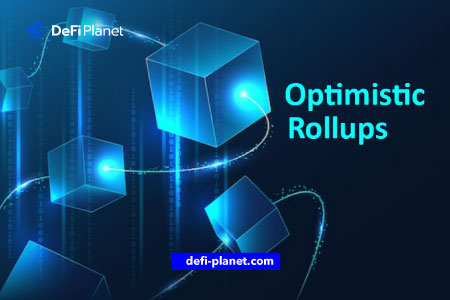Ethereum is famed as “the blockchain” for smart contracts and decentralized apps (dApps). Often utilized as the foundation for several high-power DeFi and NFT projects, it is safe to say that Ethereum has had a massive influence on the evolution of the “blockchain-cryptoverse” as we know it.
However, the massive adoption of the Ethereum blockchain has not been without downsides, the most notable of which is scalability. The Ethereum ecosystem faces certain challenges, such as achieving high throughput and low latency with limited CPU, memory, bandwidth, and disk space.
The ability of a network’s weakest node to validate the system’s rules determines the system’s scalability. A high-performance protocol is scalable if it can be used on low-resource hardware (see also DeFi Planet’s article on blockchain scalabilty to learn more).
Rollups are one of the most promising Ethereum Layer 2 solutions. These scalability solutions execute transaction computations off-chain but publish transaction data to the Ethereum chain, implying that rollups are protected by the Layer 1 chain’s security infrastructure.
All this is accomplished via smart contracts whose primary function is to bundle, or “roll up,” transaction data and move it off-chain for processing.
This data is processed by network participants known as sequencers or validators, who send back batches of highly compressed transaction data to the main chain. Those batches contain only the information required to validate the transactions. This method provides the much-needed “space” for transaction processing, improving overall chain scalability.
The main distinction between zero-knowledge (ZK) rollups and optimistic rollups is the verification method.
This guide sheds light on the operational principles of the current Layer 2 solutions (particularly Optimistic Rollups) and their role in addressing Ethereum’s scalability issues.
What is a Rollup?
Rollups execute transactions “off-chain”, which means outside the main Ethereum chain (i.e., Layer 1). They do, however, publish transaction data on Layer 1.
Off-chain or sidechain transactions are “rolled” into a single transaction, which is then committed to the Layer 1 chain. This bundle is used to create cryptographic proof. This method secures all of the bundled transactions and makes them individually verifiable.
Rollups require a separate blockchain that works with Ethereum to verify signatures, run contracts, and perform tasks requiring a smaller number of nodes or other high-performance features. Hence, before transactions are combined and committed to the main Ethereum chain, the separate blockchain can ascertain their validity.
L2 rollup sidechains manage contract execution and verification, while L1 stores immutable transaction data.
Rollups are classified into two types:
Zero-Knowledge Rollups (or ZK-Rollups)
Zero-knowledge rollups perform computations off-chain and then validate their results on the main chain. The rollup sends bundles of transactions to Layer 2 and generates a validity proof for each bundle.
The validity proofs are then submitted to Layer 1 to act as a proxy for their corresponding bundles. This technique significantly reduces data size, reducing the time and gas fees associated with validating a block.
Optimistic Rollups
Optimistic rollups, as the name implies, “optimistically assume” that transactions are genuine by default and only perform computation when there is a “challenge” through the use of fraud-proof.
Optimistic rollups have a “7-day challenge or dispute period” between submitting the rollup and acceptance on the main chain. During the dispute period, challengers can submit fraud proof for transactions deemed fraudulent.
Optimistic rollups operate securely with only honest nodes submitting fraud proofs when necessary. Optimistic rollups also leverage monetary incentives to prevent spamming the network with false fraud proofs.
What is an Optimistic Rollup?
Optimistic rollup is a Layer 2 scaling method that relies on off-chain processing to accurately process and record Layer 2 transactions. To update the “state” of the rollup on the critical underlying blockchain, the technique periodically distributes a Merkle root of the transactions that occur inside the rollup.
A network of external validators is tasked with ensuring the Merkle roots are correct before any state changes are made. If an anomaly occurs, the validator can publish a fraud proof during the argument time. This will cause the system’s configuration to “roll” back to a prior valid state.
The main advantage of optimistic rollups over zero-knowledge rollups is that they can support smart contracts in the same way that the underlying blockchain does. Apps can be easily deployed without additional programming because smart contracts are already built into the rollup.
The major disadvantage, however, is that when compared to zero-knowledge rollups, it takes longer for Layer 2 users to be able to deposit their funds back into the underlying blockchain.
Optimistic rollups require validators to check and challenge Layer 2 activity; these validators must have sufficient time to review the Merkle roots for fraud before the state can be modified.
Why Are Optimistic Rollups Important?
Ethereum is, without a doubt, the most popular platform for creating decentralized apps and smart contracts. However, the steadily rising amount of activity on Ethereum has also resulted in a significant increase in transaction costs due to limited scalability.
Due to a constant stream of transaction requests, Ethereum experiences significant network congestion. Users often have to contend with slow transaction speeds and high transaction costs.
Ethereum users often face block time and size limitations. Even though the restrictions appear necessary to maintain security and decentralization, they make it more difficult for Ethereum to grow.
These scalability issues may limit the Ethereum network’s ability to manage more users and transactions. Without scalability, it is difficult to envision the Ethereum blockchain’s future. Scaling solutions, such as sidechains and Layer 2 rollups are thus essential for addressing such issues.
Optimistic Rollup Projects
The two main competitors currently vying for dominance in the optimistic rollup market are Optimism and Arbitrum. The early successes of both companies have fueled competition between them.
The primary distinction between the two projects is the method by which they generate fraud proof. They also interact differently with Ethereum tools and the Ethereum Virtual Machine (EVM).
The top Optimistic rollup projects are described in more detail below.
Optimism
Optimism is the “firstborn” of optimistic rollups. It was the first rollup protocol to gain widespread attention in the blockchain space. Its mainnet launch, however, is a peculiar story; despite Optimism being the pioneer of optimistic rollups, Arbitrum, its fierce competitor, beat it to the mark, launching on the Ethereum mainnet first.
Despite coming in second place to Arbitrum in terms of market penetration, Optimism has had a strong run, sporting enough potential to secure $25 million in Series A funding from venture capital giant Andreessen Horowitz.
Here’s how Optimism works: A smart contract transmits transaction data from the primary Ethereum chain to a Layer 2 network, where a sequencer can organize several transactions into a single batch and send it back to the primary chain in a single transaction. While executing these tasks, the sequencers assume that the transactions are legitimate. This method allows for a one-week window during which that assumption can be challenged.
If the rollup contains any errors, this indicates that a malicious attempt was made on the network. The entire Layer 2 transaction is completed on Layer 1. This method can be used to generate proof. Completing transactions on Layer 1 is advantageous because it enables the rapid development of proofs.
Optimism, in some ways, maintains close compatibility with the Ethereum ecosystem. It utilizes a modified GETH for its Layer 2 node. It also features a Solidity compiler. It is worth noting that Solidity is the only EMV language supported on Optimism.
Arbitrum
Developed by Offchain Labs, Arbitrum is an optimistic rollup project designed to reduce Ethereum’s user prices and transaction times through off-chain computing and data storage. By working with smart contracts that are compatible with the EVM, the Arbitrum Virtual Machine (AVM) allows people to use their favourite dApps for a fraction of the price of Ethereum.
Unlike Optimism, Arbitrum does not execute the entire Layer 2 transaction. Instead, it executes transactions in small portions until an error is discovered. This method enables the smooth completion of more transactions. However, the downside of this method is that it takes too long (up to two weeks) to generate fraud-proof, consuming more time than Optimism does.
Boba Network
The Boba Network is an Ethereum L2 scaling throughput with optimistic rollup designs. Users of Boba Network’s Liquidity Provider (LP) service can withdraw money instantly instead of waiting for the seven-day challenge period to end.
Metis Andromeda
This is a scalable, cost-effective, and practical L2 protocol based on Optimistic rollups. Metis Andromeda’s unique stack can be used for a variety of purposes, including DAOs, dApps, and DeFi.
Pros and Cons of Optimistic Rollups
Optimistic rollups provide significant advantages in terms of increasing scalability without interfering with secure and trustless environments.
In terms of security, decentralization, and censorship resistance, Layer 1 storage of transaction data is preferable.
Because optimistic rollups work with Solidity and EVM, Ethereum-based smart contracts can be converted to optimistic rollups.
However, optimistic rollups have significant drawbacks, such as delays in transaction finality and potential power abuse by sequencers.
Furthermore, a lack of trustworthy nodes can increase the likelihood of fraud through erroneous state commitments and blocks.
Lastly, rollups are expected to commit transaction data on-chain, thereby increasing costs.
In Conclusion,
- Optimistic rollups are far more practical and useful than ZK Rollups since they do not require complex computations.
- Optimistic rollups scale about 100 times more effectively than the Layer 1 Ethereum chain. The Ethereum network will be less congested if most users adopt this scaling method.
- Also, optimistic rollups give developers access to unique techniques that make it easier to develop decentralized apps without having to worry about costs or timelines.
- As the world of decentralized applications and smart contracts continues to evolve, the benefits of optimistic rollups will, without a doubt, become more apparent.
If you would like to read more articles like this, visit DeFi Planet and follow us on Twitter, LinkedIn, Facebook, and Instagram.
“Take control of your crypto portfolio with MARKETS PRO, DeFi Planet’s suite of analytics tools.”





















